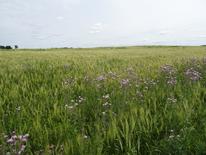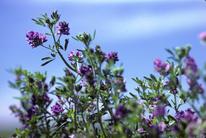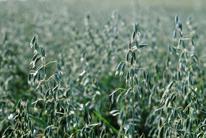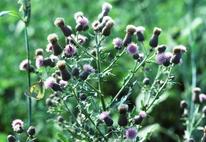By Jill Sackett Eberhart
Edited by Steve Simmons, Kristine Moncada, Craig Sheaffer, Gigi DiGiacomo and Nicole Tautges
Chris and Sarah Feely have been farming in west central Minnesota for over 40 years. More than just a job, farming was a career and a calling for Chris. The Feelys felt strongly that it was important to be good stewards of the land, and were well aware of the impact their decisions had on their farm’s natural resources. These values motivated their choice to utilize organic farming practices.
The farm soil was predominantly clay-loam and the average yearly precipitation was slightly less than 25 inches per year. With roughly 300 acres of land to make a living from, Chris paid close attention to soil conservation and chose a rotation that reflected his desire to improve the soil.
Chris planted a three-year rotation of corn-soybean-small grain, but would sometimes add a year or two of alfalfa after the small grain. Chris included multiple kinds of spring-planted small grains in his rotation over the years, from oats to barley to spring wheat. These he would no-till drill into soybean stubble. He often underseeded those spring small grains with a legume such as red clover or alfalfa. The small grain acts as a companion crop forming a canopy over the smaller legume seedling. After small grain harvest, the legume seedlings remain and regrow to provide soil cover for the remainder of that growing season, and in addition, supply nitrogen to the next crop. This is particularly important for organic farmers as they cannot use synthetic nitrogen fertilizers used by conventional growers.
Chris would usually choose perennial legumes such as red clover or alfalfa to be under-seeded. In the years that Chris planted red clover with the small grain, he would use tillage in the spring of the following year to terminate the red clover in order to plant the next crop in his rotation. When he would underseed with alfalfa, he allowed it to grow for the entire next season and would harvest it several times and sell it as forage. Therefore, for Chris, the underseeded legumes provided winter cover and were a source of fertility for the next year’s corn crop. In the years that alfalfa was grown, it was also a source of income.
A New Crop in the Rotation
Chris enjoyed learning about, and experimenting with, new agricultural techniques that had the potential of improving his farm. He was intrigued by the potential of winter wheat. Unlike the other grain crops Chris grew, winter wheat was planted in early September. Winter wheat’s fall and early spring growth helped conserve topsoil by keeping the ground covered through fall, winter and spring. Underseeding a legume with his spring-planted small grains provided this benefit, too, but winter wheat had the potential of providing a better financial return than the legumes. In addition, when compared to the spring-seeded small grains, winter wheat required no spring tillage, and was a good competitor against weeds.
Chris began a new rotation of corn-soybean-small grain-small grain so that he could start including winter wheat. The spring-planted small grains were harvested in August and gave Chris plenty of time to no-till drill winter wheat into their stubble within weeks of their harvest. A spring small grain followed by a winter small grain was an unusual practice because of concerns of disease pressure, but Chris found out that his organic certifying agency allowed the practice. Understanding the risk of disease, Chris chose to plant winter wheat after either oats or barley rather than spring wheat.
His new rotation meant that he had to give up the practice of underseeding red clover or alfalfa with his spring small grains. The clover or alfalfa just wouldn’t have enough time to regrow following the spring-planted small grain harvest before it needed to be terminated to plant the winter wheat. As a result, Chris didn’t get the nitrogen benefit from the use of legumes. However, this was not much of a concern because he had developed a relationship with a neighboring hog farmer and now had a reliable source of livestock manure to provide nutrients for his crops.
Chris was pleased with how no-till planting winter wheat reduced his fall and spring tillage in contrast to underseeded red clover, which he controlled with a chisel plow in the spring. While organic farmers use tillage to kill weeds and prepare the soil for planting, tillage also damages soil structure and can lead to increased soil erosion. Chris knew that reducing the number of tillage passes, especially in the fall, was better for the soil. Plus, winter wheat, just like the underseeded legumes, was able to provide soil cover.
Weed Control Issues
Soil fertility and conservation were important to Chris, but so was weed control. As many organic farmers would agree, weed control was a constant concern. Alfalfa and red clover in the rotation not only helped provide nitrogen for the corn crop, but also helped reduce perennial weed pressure. In fact, planting alfalfa in fields that had troublesome perennial weed issues was a tactic on which Chris regularly used to aid in weed control. Harvesting of alfalfa by mowing three times per year removed weeds and prevented their seed production. The underseeding of red clover could also provide some of the same weed management benefits, even though it was mowed less frequently than alfalfa and not harvested.
But now, there was a new crop in the rotation. Including winter wheat meant that the practice of underseeding was no longer being done. As time went by, Chris noticed that the use of winter wheat in the rotation was resulting in an unexpected weed issue. Canada thistle, in particular was becoming a problem. Chris particularly noticed its regrowth and spread after winter wheat harvest in July.
Canada thistle is a perennial broadleaf weed that can be difficult to manage, and becomes particularly troublesome in organic no-till rotations. Chris wasn’t happy to see it in his fields. Canada thistle can spread by either seed or via its extensive root system. Seedlings emerge from May to June and eventually produce numerous flowers and seeds. The seeds are tufted and easily spread by the wind. Plus, Canada thistle can grow from just one, small piece of root as well as sucker from one plant’s extensive root system. This means that tillage can spread it, too. It reduces yields because it is highly competitive for nutrients and water.
What were Chris’s options? His original rotation offered Chris the opportunity to underseed a legume with his small grains. Whether alfalfa or red clover, the legume provided soil surface protection as well as helped to increase soil fertility. It also was good for perennial weed control, especially when the alfalfa was allowed to grow and be harvested for one or two years after the small grain crop.
Winter wheat had become a valuable small grain in Chris’s new rotation. The growth habit of winter wheat was beneficial since it was present during late fall, winter, and spring to help prevent soil erosion. Having a winter annual in the rotation also added diversity. However, Canada thistle was a problem that began showing up once the winter wheat was put into the rotation.
Should Chris discontinue the use of winter wheat in his rotation? If he chose to continue to grow winter wheat, how could he manage the Canada thistle? Are there other crops Chris could add to his rotation to compete with Canada thistle? How could Chris have the best of both worlds?
* While these cases describe actual situations, names have been changed.
Access the complete decision case study with all educational materials (pdf) >>>
You may cite this publication as:
Eberhart, J. 2017. Will Changing the Rotation Change It All? A Decision Case Study in Principles for Transitioning to Organic Farming: e-Learning Materials and Decision Case Studies for Educators. S. Simmons, K. Moncada, C. Sheaffer, G. DiGiacomo, and N. Tautges (Eds).University of Minnesota, St. Paul, MN.



